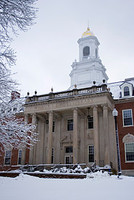The stacks and online databases of hopeful, entrance applications for the incoming 2009-2010 freshmen class have grown sharply for the nation’s top, competitive schools, decreasing the chances of acceptance, according to新York Times.
Harvard, Stanford, Dartmouth, Yale and Brown are some of the more recognizable schools that saw increases in applications. These schools have traditionally been highly selective, and they have scrutinized applications further, making it one of the toughest years for hopeful students.
The Timesreported that the percentage of students accepted into these competitive colleges has been or near record lows.
Bill Fitzsimmons, dean of admissions and financial aid at Harvard since 1986, told新York Timesthat Harvard had a record high number of applications for this year with 29,112. This marked a 6% increase from last year. He said that the percentage of students admitted dropped from 8% last year to 7%.
Dartmouth had a similar numbers with 18,130 applications and a 12% acceptance rate, both of which were records.
Stanford had a 20% increase in applications with 30,350 with an estimated 7.5% acceptance rate, which would be its lowest in school history.
Furthermore, Yale, Brown, Columbia, Cornell, the University of Pennsylvania and Princeton all experienced increases in applications. Brown reported increases of 21%, Yale 14%, Columbia 13%, Cornell 3%, the University of Pennsylvania 4% and Princeton said it was up 2% as of January, according to新York Times.
Despite the increase of interest in Ivy League Schools and many other elite, selective colleges, many liberal arts schools had a decline in applications, according to新York Times.
Williams College’s, in Massachusetts, overall applications dropped 20%, which increased the percentage of accepted students to 20%.新Yorktimes attributed the school’s drop to its location.新York Timesreported that travelling to and from school could be expensive because Williams College is distant from any major city or airport.
Middlebury College in Vermont had a 12% drop in applications for similar reasons, according to新York Times.
Amherst, a Williams College rival, in Massachusetts reported that applications were down 1%; however, the college boosted its admission rate to 16% because Amherst wants to increase its number of first-year students by 25.
Wesleyan University in Connecticut, however, had a 22% increase in applications, dropping its admission rate by 5% to 22%.
There were not many changes in the common application, an online application that over 350 universities accept, according to新York Times.
The Timesalso reported that there has been a surge in applications for major, well-known public universities. The University of North Carolina at Chapel Hill, The University of Michigan at Ann Arbor and The University of Virginia in Charlottesville all saw gains in the number of applications.
Because of these increasing statistics, students will find it increasingly difficult and more competitive to get into these elite universities.
The chance of that acceptance letter bearing good news in the mailbox is greatly decreasing.
The U.S News and World Report reported its rankings of the best, national schools in mid June, 2009.
1. Harvard University: Cambridge, MA
2. Princeton University: Princeton, NJ
3. Yale University: New Haven, CT
4. Massachusetts Institute of Technology: Cambridge, MA
4. Stanford University: Stanford, CA
6. California Institute of Technology: Pasadena, CA
6. University of Pennsylvania: Philadelphia, PA
8. Columbia University: New York, NY
8. Duke University: Durham, NC
8. University of Chicago: Chicago, IL
11. Dartmouth University: Hanover, NH
12. Northwestern University: Evanston, IL
12. Washington University: Saint Louis, MO
14. Cornell University: Ithaca, NY
15. Johns Hopkins University: Baltimore, MD
16. Brown University: Providence, RI





